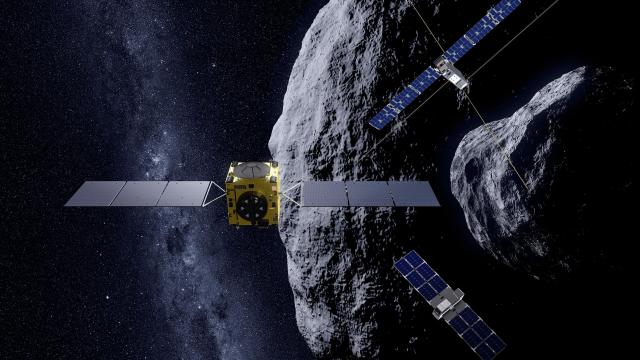NASA’s DART probe, in one of the most dramatic space missions ever, crashed into the Dimorphos asteroid yesterday to test the ability of a spacecraft to deflect an asteroid. Now, the European Space Agency is taking the next big step by preparing its HERA probe for a trip to the post-impact asteroid.
Last night’s impact of Dimorphos by DART proved successful with the spacecraft’s video feed showing the probe inching ever closer to — and eventually reaching the surface of — the tiny asteroid. The DART mission was a bid by NASA to test a planetary defence strategy that could eventually protect us against incoming asteroids. Now that NASA has smashed into the asteroid, a next important step will be to figure out just how successful the mission actually was at deflecting an asteroid. To that end, ESA is preparing its HERA probe, which will travel to and investigate Dimorphos, the junior member of the Didymos binary asteroid system. HERA is scheduled to launch in October 2o24.
“The deflection by DART will be measurable from [the] ground with telescopes,” said HERA project manager Ian Carnelli in an ESA video. “However only with HERA coming up-close and inspecting the asteroid will [we uncover] all of those parameters that will allow us to plan for a deflection mission if one day we need one.”
DART brought a lone sidekick along with it to the binary asteroid system, LICIACube. Early images from the Italian probe are quite mind-blowing, but LICIACube won’t be sticking around. Hence the need for a return mission.
Unlike DART, HERA will not ram itself into Dimorphos, and instead of bringing one companion, HERA will bring two. Once at the moonlet, HERA will evaluate any changes in Dimporphos’s orbital trajectory, in addition to gathering surface and internal characteristic data on Dimorphos and its larger counterpart, Didymos. HERA’s sidekicks, two cubesats named Milani and Juventas, are each about the size of a shoebox.
Milani will perform spectral analyses of Dimorphos to characterise the asteroid’s composition. To do so, the tiny probe will study any lingering dust clouds, in addition to evaluating the effects of the DART impact. Juventas will perform geophysical analyses of Dimorphos by measuring the asteroid’s gravity field and internal structure. While HERA is a little over two years away from launch, it is not expected to rendezvous with Dimorphos until December 2026.
The DART mission was an incredibly exciting example of NASA’s ingenuity, but also a reminder of the many dangers that could be lurking throughout the solar system. HERA will hopefully garner the same public enthusiasm that greeted the DART mission, with the the upcoming mission furthering our efforts to develop an effective planetary defence strategy.
